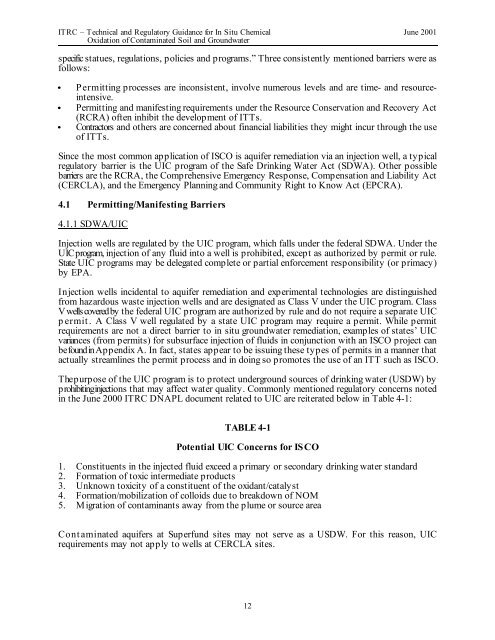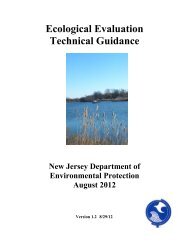Technical and Regulatory Guidance for In Situ Chemical ... - ITRC
Technical and Regulatory Guidance for In Situ Chemical ... - ITRC
Technical and Regulatory Guidance for In Situ Chemical ... - ITRC
Create successful ePaper yourself
Turn your PDF publications into a flip-book with our unique Google optimized e-Paper software.
<strong>ITRC</strong> – <strong>Technical</strong> <strong>and</strong> <strong>Regulatory</strong> <strong>Guidance</strong> <strong>for</strong> <strong>In</strong> <strong>Situ</strong> <strong>Chemical</strong> June 2001<br />
Oxidation of Contaminated Soil <strong>and</strong> Groundwater<br />
specific statues, regulations, policies <strong>and</strong> programs.” Three consistently mentioned barriers were as<br />
follows:<br />
C<br />
C<br />
C<br />
Permitting processes are inconsistent, involve numerous levels <strong>and</strong> are time- <strong>and</strong> resourceintensive.<br />
Permitting <strong>and</strong> manifesting requirements under the Resource Conservation <strong>and</strong> Recovery Act<br />
(RCRA) often inhibit the development of ITTs.<br />
Contractors <strong>and</strong> others are concerned about financial liabilities they might incur through the use<br />
of ITTs.<br />
Since the most common application of ISCO is aquifer remediation via an injection well, a typical<br />
regulatory barrier is the UIC program of the Safe Drinking Water Act (SDWA). Other possible<br />
barriers are the RCRA, the Comprehensive Emergency Response, Compensation <strong>and</strong> Liability Act<br />
(CERCLA), <strong>and</strong> the Emergency Planning <strong>and</strong> Community Right to Know Act (EPCRA).<br />
4.1 Permitting/Manifesting Barriers<br />
4.1.1 SDWA/UIC<br />
<strong>In</strong>jection wells are regulated by the UIC program, which falls under the federal SDWA. Under the<br />
UIC program, injection of any fluid into a well is prohibited, except as authorized by permit or rule.<br />
State UIC programs may be delegated complete or partial en<strong>for</strong>cement responsibility (or primacy)<br />
by EPA.<br />
<strong>In</strong>jection wells incidental to aquifer remediation <strong>and</strong> experimental technologies are distinguished<br />
from hazardous waste injection wells <strong>and</strong> are designated as Class V under the UIC program. Class<br />
V wells covered by the federal UIC program are authorized by rule <strong>and</strong> do not require a separate UIC<br />
p ermit . A Class V well regulated by a state UIC program may require a permit. While permit<br />
requirements are not a direct barrier to in situ groundwater remediation, examples of states’ UIC<br />
variances (from permits) <strong>for</strong> subsurface injection of fluids in conjunction with an ISCO project can<br />
be found in Appendix A. <strong>In</strong> fact, states appear to be issuing these types of permits in a manner that<br />
actually streamlines the permit process <strong>and</strong> in doing so promotes the use of an ITT such as ISCO.<br />
The purpose of the UIC program is to protect underground sources of drinking water (USDW) by<br />
prohibiting injections that may affect water quality. Commonly mentioned regulatory concerns noted<br />
in the June 2000 <strong>ITRC</strong> DNAPL document related to UIC are reiterated below in Table 4-1:<br />
TABLE 4-1<br />
Potential UIC Concerns <strong>for</strong> ISCO<br />
1. Constituents in the injected fluid exceed a primary or secondary drinking water st<strong>and</strong>ard<br />
2. Formation of toxic intermediate products<br />
3. Unknown toxicity of a constituent of the oxidant/catalyst<br />
4. Formation/mobilization of colloids due to breakdown of NOM<br />
5. Migration of contaminants away from the plume or source area<br />
Cont aminated aquifers at Superfund sites may not serve as a USDW. For this reason, UIC<br />
requirements may not apply to wells at CERCLA sites.<br />
12
















